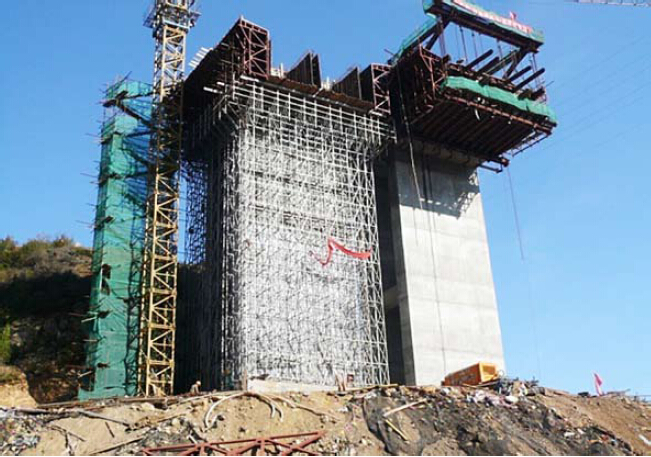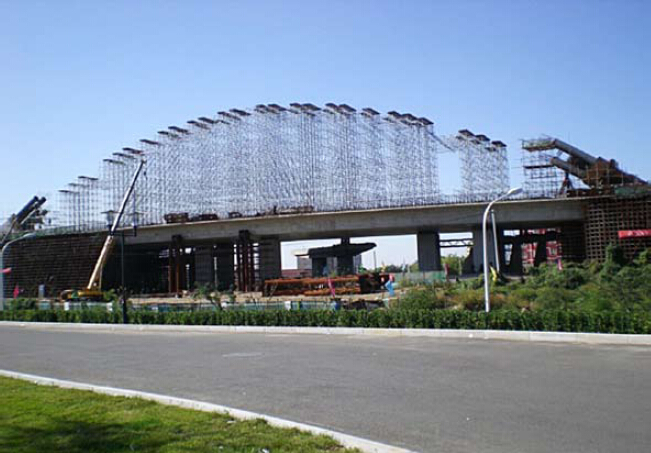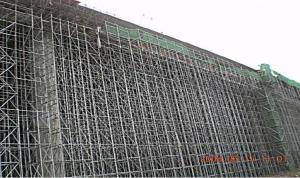Tower-Scaffolding for Formwork and Scaffolding systems
- Loading Port:
- Tianjin
- Payment Terms:
- TT OR LC
- Min Order Qty:
- 50 m²
- Supply Capability:
- 1000 m²/month
OKorder Service Pledge
Quality Product, Order Online Tracking, Timely Delivery
OKorder Financial Service
Credit Rating, Credit Services, Credit Purchasing
You Might Also Like
Tower Scaffolding
Shoring tower is an effective supporting system. It is easy to assemble and dismantlement, and
has excellent stability and bearing capacity. It has been widely used in the construction of industry
& residential buildings , bridges, tunnels and dam project, etc.
Characteristics:
◆ High degree of standardization.
◆ Easy storage and transportation


- Q:How does steel formwork handle reinforcement placement?
- Steel formwork is a versatile and popular option in construction because of its strength, durability, and efficient reinforcement placement. When it comes to handling reinforcement placement, steel formwork offers multiple advantages. To begin with, steel formwork provides a sturdy structure that can withstand the weight and pressure of reinforcement bars. This ensures that the bars remain in their desired position during the concrete pouring process, eliminating the risk of deformation or displacement. Consequently, the structural integrity of the final concrete structure is ensured. Moreover, steel formwork comes with pre-determined holes and slots, enabling precise placement of reinforcement bars. These pre-designed openings allow for quick and accurate installation of the bars, reducing the time and effort required for reinforcement placement. Additionally, steel formwork offers the flexibility to adjust the position of the reinforcement bars if necessary, ensuring optimal placement for specific project requirements. Furthermore, steel formwork provides easy access to the reinforcement bars during concrete pouring. Removable panels or openings can be incorporated into the formwork design, allowing construction workers to monitor and adjust the placement of reinforcement bars as needed. This accessibility guarantees proper positioning of the reinforcement, preventing any potential weak areas or structural deficiencies in the concrete structure. Lastly, steel formwork allows for efficient integration of various reinforcement elements, such as steel mesh, rebar cages, or post-tensioning systems. The formwork system can be designed to accommodate these different reinforcement methods, ensuring compatibility and ease of installation. This flexibility in reinforcement placement is particularly advantageous for complex or intricate concrete structures that require specific reinforcement configurations. In conclusion, steel formwork is well-suited to handle reinforcement placement efficiently. Its strength, rigidity, and pre-designed openings enable accurate and secure positioning of reinforcement bars. The accessibility and adaptability of steel formwork further enhance its capability to handle various reinforcement elements, ensuring the integrity and strength of the final concrete structure.
- Q:Is steel formwork more durable than other types of formwork?
- Yes, steel formwork is generally considered more durable than other types of formwork. Steel has high strength and can withstand heavy loads, making it ideal for construction projects that require repetitive use and long-term durability. Additionally, steel formwork is resistant to warping, shrinking, and moisture damage, which further enhances its durability compared to other formwork materials such as wood or aluminum.
- Q:What are the different sizes and dimensions available for steel formwork panels?
- The sizes and dimensions of steel formwork panels can vary depending on the manufacturer and specific project requirements. However, common sizes range from 1.2 meters by 1.8 meters to 3 meters by 6 meters. Additionally, panels can have different thicknesses, typically ranging from 12mm to 18mm.
- Q:Can steel formwork be used for structures with complex geometries?
- Structures with complex geometries can indeed utilize steel formwork. The versatility of steel formwork allows for easy customization to match the specific shape and dimensions of the structure. Its strength, durability, and flexibility are well-known attributes, making it suitable for constructing intricate designs and complex geometries. Steel formwork systems can be adjusted, assembled, and disassembled to create unique architectural elements and complex structural configurations. Furthermore, steel formwork guarantees a smooth and precise finish, ensuring the accuracy and quality of the final structure. In conclusion, steel formwork is a dependable and efficient choice for constructing structures with complex geometries.
- Q:Are there any health concerns associated with steel formwork?
- Steel formwork is generally considered safe to use in construction projects, but there are a few health concerns associated with its use. One of the main concerns is the potential for exposure to hazardous substances during the fabrication, handling, and installation of steel formwork. Firstly, steel formwork is typically coated with protective paints or coatings to prevent corrosion. However, these coatings may contain harmful chemicals such as volatile organic compounds (VOCs) or heavy metals like lead or chromium. Inhalation or skin contact with these substances can pose health risks, especially if proper protective measures are not taken. Secondly, steel formwork can be quite heavy and cumbersome to handle, which can lead to musculoskeletal injuries for workers. Lifting, carrying, and positioning heavy steel formwork can strain the back, shoulders, and other parts of the body, potentially causing long-term damage if proper lifting techniques and equipment are not used. Additionally, steel formwork can generate noise and vibration during the construction process. Prolonged exposure to excessive noise levels can lead to hearing loss and other auditory problems. Vibrations caused by machinery or tools can also cause hand-arm vibration syndrome, a condition characterized by numbness, tingling, and reduced sensation in the hands and arms. To mitigate these health concerns, it is important to adhere to safety guidelines and regulations when working with steel formwork. This includes providing workers with appropriate personal protective equipment (PPE) such as gloves, masks, and safety glasses to minimize exposure to hazardous substances. Regular maintenance and inspection of the formwork should also be conducted to ensure the integrity of the protective coatings and prevent any potential health risks. Furthermore, proper training on safe lifting techniques and the use of mechanical aids can help prevent musculoskeletal injuries. Noise control measures such as using quieter equipment and implementing engineering controls like barriers or enclosures can help reduce noise levels. Lastly, providing breaks and rotation of tasks can help minimize the risk of hand-arm vibration syndrome. In conclusion, while steel formwork is generally safe to use, there are some health concerns associated with its use. These include potential exposure to hazardous substances, musculoskeletal injuries, and noise and vibration-related health issues. However, by implementing appropriate safety measures and providing proper training and equipment, these concerns can be effectively managed to ensure the health and well-being of workers in construction projects.
- Q:How does steel formwork contribute to the overall thermal insulation of the building?
- The use of steel formwork in construction does not directly impact the building's thermal insulation. However, it plays a vital role in shaping the concrete walls, floors, and ceilings, which indirectly affects the building's thermal insulation. During construction, steel formwork acts as a temporary mold or framework for pouring concrete. It provides necessary support and holds the concrete in place until it solidifies and gains strength. On the other hand, the concrete itself acts as a thermal mass, absorbing, storing, and releasing heat energy. The primary factors that determine a building's thermal insulation are materials like insulation boards, windows, doors, and the overall design of the building envelope. These components work together to reduce heat transfer and maintain a comfortable indoor temperature. Nevertheless, if the steel formwork lacks proper insulation or if there are gaps between the formwork and the insulation, thermal bridges can occur. These bridges allow heat to easily transfer between the interior and exterior of the building, leading to energy loss and diminished thermal performance. To address this issue, it is crucial to ensure that the steel formwork is adequately insulated and any gaps or joints are properly sealed. This can be achieved by incorporating insulation materials, such as rigid foam boards or spray foam insulation, between the formwork and the concrete. In conclusion, while steel formwork itself does not contribute to a building's thermal insulation, its correct installation and appropriate insulation around it can help prevent thermal bridges and enhance the overall thermal performance of the structure.
- Q:What are the different types of joints used with steel formwork?
- The different types of joints used with steel formwork include bolted joints, welded joints, and interlocking joints.
- Q:Can steel formwork be reused?
- Yes, steel formwork can be reused. Steel formwork is a durable and robust material that can withstand multiple uses. It offers a longer lifespan compared to other types of formwork materials such as timber or plywood. One of the main advantages of using steel formwork is its ability to be easily dismantled and reassembled. This allows for the formwork to be reused on different construction projects, reducing the need for new materials and saving costs. Furthermore, steel formwork is resistant to weather conditions and moisture, which contributes to its longevity. It can withstand the pressure exerted by concrete during pouring and curing without warping or deforming, ensuring a consistent and high-quality finish. Additionally, steel formwork can be easily cleaned and maintained, making it suitable for reuse. After each use, the formwork can be cleaned and inspected to ensure it is in good condition for the next project. Any necessary repairs or replacements can be made to ensure its structural integrity. In summary, steel formwork can be reused due to its durability, strength, resistance to weather conditions, and ease of maintenance. Reusing steel formwork not only saves costs but also contributes to sustainable construction practices by reducing waste and conserving resources.
- Q:What are the common design considerations for steel formwork?
- To ensure the efficiency and effectiveness of steel formwork design, several factors must be taken into account. Firstly, the load-bearing capacity of the formwork needs careful calculation and design to support the weight of fresh concrete and any additional loads without deformation or failure. This involves evaluating maximum expected load and selecting the appropriate steel grade and thickness. Secondly, the formwork should be easily assembled and disassembled, which is crucial for projects with tight schedules or limited space. Modular components that can be quickly and accurately connected should be used, allowing for efficient construction and easy removal after the concrete cures. Thirdly, the desired surface finish of the concrete should be considered in the formwork design. Proper alignment and leveling are necessary for a smooth and consistent finish. Additionally, the formwork should be designed to prevent leakage or seepage, which could cause imperfections or structural issues. Stability and rigidity are also important considerations. The formwork must withstand lateral pressure from the fresh concrete without significant deformation or displacement. Proper bracing and tie systems should be incorporated for stability during the pouring process. Safety should be prioritized in the formwork design, providing a safe working environment with adequate access, guardrails, and fall protection systems. Installation and removal of safety features should also be considered. Lastly, the reusability and durability of the steel components should be taken into account. The formwork should be designed to withstand repeated use and resist corrosion or wear. Maintenance and storage considerations are also important for prolonging the lifespan of the formwork. In conclusion, the design of steel formwork should consider load-bearing capacity, ease of assembly and disassembly, surface finish requirements, stability and rigidity, safety, reusability, and durability. By carefully considering these factors, well-designed steel formwork can contribute to the successful and efficient construction of concrete structures.
- Q:Can steel formwork be used for projects with high concrete durability demands?
- Yes, steel formwork can be used for projects with high concrete durability demands. Steel formwork is renowned for its strength, stability, and ability to withstand repeated use. It provides a smooth and even surface finish to the concrete, ensuring high-quality results. Additionally, steel formwork is resistant to warping or distortion, which can affect the durability of the concrete structure. Thus, it is a reliable choice for projects that require high concrete durability.
1. Manufacturer Overview |
|
|---|---|
| Location | |
| Year Established | |
| Annual Output Value | |
| Main Markets | |
| Company Certifications | |
2. Manufacturer Certificates |
|
|---|---|
| a) Certification Name | |
| Range | |
| Reference | |
| Validity Period | |
3. Manufacturer Capability |
|
|---|---|
| a)Trade Capacity | |
| Nearest Port | |
| Export Percentage | |
| No.of Employees in Trade Department | |
| Language Spoken: | |
| b)Factory Information | |
| Factory Size: | |
| No. of Production Lines | |
| Contract Manufacturing | |
| Product Price Range | |
Send your message to us
Tower-Scaffolding for Formwork and Scaffolding systems
- Loading Port:
- Tianjin
- Payment Terms:
- TT OR LC
- Min Order Qty:
- 50 m²
- Supply Capability:
- 1000 m²/month
OKorder Service Pledge
Quality Product, Order Online Tracking, Timely Delivery
OKorder Financial Service
Credit Rating, Credit Services, Credit Purchasing
Similar products
New products
Hot products
Hot Searches
Related keywords























